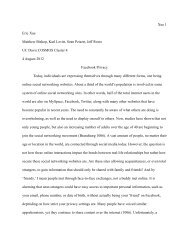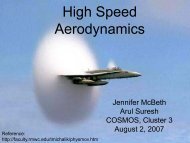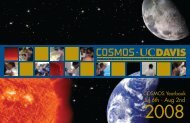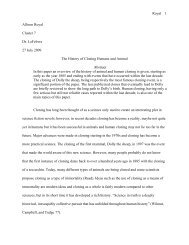Ding, Anthony - COSMOS - UC Davis
Ding, Anthony - COSMOS - UC Davis
Ding, Anthony - COSMOS - UC Davis
You also want an ePaper? Increase the reach of your titles
YUMPU automatically turns print PDFs into web optimized ePapers that Google loves.
H-R diagram of M29 4<br />
This is why star clusters, in which all the stars are the same distance away from the Earth,<br />
are ideal stellar objects to plot on H-R diagrams.<br />
There are two possible type of star clusters, open, also known as galactic, star<br />
clusters and globular star clusters (Schneider and Arny 2009). The major difference<br />
between the two is that an open cluster is relatively young with well-dispersed stars and<br />
an unsymmetrical shape, while globular clusters are relatively old with concentrated stars<br />
and spherical shape. M29, also known as NGC 6913, is an open cluster located in the<br />
constellation Cygnus. Open clusters are born through the condensation of a single gas<br />
cloud (Schneider and Arny 2009). This means that in addition to being roughly the same<br />
age, the stars in an open cluster will be the same distance from Earth and have the same<br />
chemical composition (Frommert and Kronberg 2007). Because many of the properties of<br />
stars in an open cluster are the same, plotting the stars on an H-R diagram is very useful<br />
for comparing the properties that aren’t the same.<br />
When you plot an open cluster on an H-R diagram, you get a characteristic line<br />
starting from the top left, flattening out in the middle, and ending in the bottom right.<br />
This sequence of stars is called the main sequence (Schneider and Arny 2009). In general,<br />
stars in the main sequence are newly formed and burn through a process of nuclear fusion,<br />
where hydrogen nuclei are fused to create a helium nuclei; in fact, our sun is one such<br />
main sequence star. Stars spend most of their lives in the main sequence. As their fuel<br />
burns out, the stars will eventually branch out of the main sequence. Stars that are in the<br />
middle of their lifetimes can be found in the Red Giant branch, where they will<br />
eventually burn out completely and turn into a white dwarf star (Iben 1966). In addition,<br />
some stars may take an alternate path and branch off into what is known as the Horizontal

















